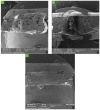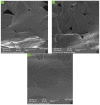Direct Pellet Three-Dimensional Printing of Polybutylene Adipate-co-Terephthalate for a Greener Future
- PMID: 38257066
- PMCID: PMC10820913
- DOI: 10.3390/polym16020267
Direct Pellet Three-Dimensional Printing of Polybutylene Adipate-co-Terephthalate for a Greener Future
Abstract
The widespread use of conventional plastics in various industries has resulted in increased oil consumption and environmental pollution. To address these issues, a combination of plastic recycling and the use of biodegradable plastics is essential. Among biodegradable polymers, poly butylene adipate-co-terephthalate (PBAT) has attracted significant attention due to its favorable mechanical properties and biodegradability. In this study, we investigated the potential of using PBAT for direct pellet printing, eliminating the need for filament conversion. To determine the optimal printing temperature, three sets of tensile specimens were 3D-printed at varying nozzle temperatures, and their mechanical properties and microstructure were analyzed. Additionally, dynamic mechanical thermal analysis (DMTA) was conducted to evaluate the thermal behavior of the printed PBAT. Furthermore, we designed and printed two structures with different infill percentages (40% and 60%) to assess their compressive strength and energy absorption properties. DMTA revealed that PBAT's glass-rubber transition temperature is approximately -25 °C. Our findings demonstrate that increasing the nozzle temperature enhances the mechanical properties of PBAT. Notably, the highest nozzle temperature of 200 °C yielded remarkable results, with an elongation of 1379% and a tensile strength of 7.5 MPa. Moreover, specimens with a 60% infill density exhibited superior compressive strength (1338 KPa) and energy absorption compared with those with 40% infill density (1306 KPa). The SEM images showed that with an increase in the nozzle temperature, the quality of the print was greatly improved, and it was difficult to find microholes or even a layered structure for the sample printed at 200 °C.
Keywords: 3D printing; PBAT; biodegradable plastics; material extrusion; mechanical properties; nozzle temperature.
Conflict of interest statement
The authors declare no conflicts of interest.
Figures









Similar articles
-
Preparation and Characterization of Triglycine-Containing 3D-Printed PBAT/PLA Specimens.ACS Omega. 2025 May 26;10(22):23817-23826. doi: 10.1021/acsomega.5c03205. eCollection 2025 Jun 10. ACS Omega. 2025. PMID: 40521449 Free PMC article.
-
Physical, Mechanical, and Structural Properties of the Polylactide and Polybutylene Adipate Terephthalate (PBAT)-Based Biodegradable Polymer during Compost Storage.Polymers (Basel). 2023 Mar 24;15(7):1619. doi: 10.3390/polym15071619. Polymers (Basel). 2023. PMID: 37050232 Free PMC article.
-
FDM 3D Printing and Properties of PBAT/PLA Blends.Polymers (Basel). 2024 Apr 18;16(8):1140. doi: 10.3390/polym16081140. Polymers (Basel). 2024. PMID: 38675058 Free PMC article.
-
Biodegradable Nanocomposites Based on Blends of Poly(Butylene Adipate-Co-Terephthalate) (PBAT) and Thermoplastic Starch Filled with Montmorillonite (MMT): Physico-Mechanical Properties.Materials (Basel). 2024 Jan 23;17(3):540. doi: 10.3390/ma17030540. Materials (Basel). 2024. PMID: 38591383 Free PMC article.
-
Binary Green Blends of Poly(lactic acid) with Poly(butylene adipate-co-butylene terephthalate) and Poly(butylene succinate-co-butylene adipate) and Their Nanocomposites.Polymers (Basel). 2021 Jul 28;13(15):2489. doi: 10.3390/polym13152489. Polymers (Basel). 2021. PMID: 34372090 Free PMC article. Review.
Cited by
-
Effect of Post-Printing Conditions on the Mechanical and Optical Properties of 3D-Printed Dental Resin.Polymers (Basel). 2024 Jun 15;16(12):1713. doi: 10.3390/polym16121713. Polymers (Basel). 2024. PMID: 38932063 Free PMC article.
-
Application of PLGA in Tumor Immunotherapy.Polymers (Basel). 2024 Apr 30;16(9):1253. doi: 10.3390/polym16091253. Polymers (Basel). 2024. PMID: 38732722 Free PMC article. Review.
-
4D Printing of Multifunctional and Biodegradable PLA-PBAT-Fe3O4 Nanocomposites with Supreme Mechanical and Shape Memory Properties.Macromol Rapid Commun. 2025 Jan;46(2):e2400661. doi: 10.1002/marc.202400661. Epub 2024 Oct 14. Macromol Rapid Commun. 2025. PMID: 39401289 Free PMC article.
-
Carbon Fiber Reinforced Thermoplastics: From Materials to Manufacturing and Applications.Adv Mater. 2025 Jul;37(27):e2418709. doi: 10.1002/adma.202418709. Epub 2025 Apr 22. Adv Mater. 2025. PMID: 40263922 Free PMC article. Review.
-
Various FDM Mechanisms Used in the Fabrication of Continuous-Fiber Reinforced Composites: A Review.Polymers (Basel). 2024 Mar 18;16(6):831. doi: 10.3390/polym16060831. Polymers (Basel). 2024. PMID: 38543436 Free PMC article. Review.
References
-
- Kanwal A., Zhang M., Sharaf F., Li C. Polymer pollution and its solutions with special emphasis on Poly (butylene adipate terephthalate (PBAT)) Polym. Bull. 2022;79:9303–9330. doi: 10.1007/s00289-021-04065-2. - DOI
-
- Jian J., Xiangbin Z., Xianbo H. An overview on synthesis, properties and applications of poly(butylene-adipate-co-terephthalate)–PBAT. Adv. Ind. Eng. Polym. Res. 2020;3:19–26. doi: 10.1016/j.aiepr.2020.01.001. - DOI
-
- Kanwal A., Zhang M., Sharaf F., Li C. Enzymatic degradation of poly (butylene adipate co-terephthalate) (PBAT) copolymer using lipase B from Candida antarctica (CALB) and effect of PBAT on plant growth. Polym. Bull. 2022;79:9059–9073. doi: 10.1007/S00289-021-03946-W/METRICS. - DOI
-
- Witt U., Einig T., Yamamoto M., Kleeberg I., Deckwer W.D., Müller R.J. Biodegradation of aliphatic–aromatic copolyesters: Evaluation of the final biodegradability and ecotoxicological impact of degradation intermediates. Chemosphere. 2001;44:289–299. doi: 10.1016/S0045-6535(00)00162-4. - DOI - PubMed
-
- Weng Y.X., Jin Y.J., Meng Q.Y., Wang L., Zhang M., Wang Y.Z. Biodegradation behavior of poly(butylene adipate-co-terephthalate) (PBAT), poly(lactic acid) (PLA), and their blend under soil conditions. Polym. Test. 2013;32:918–926. doi: 10.1016/J.POLYMERTESTING.2013.05.001. - DOI
LinkOut - more resources
Full Text Sources

